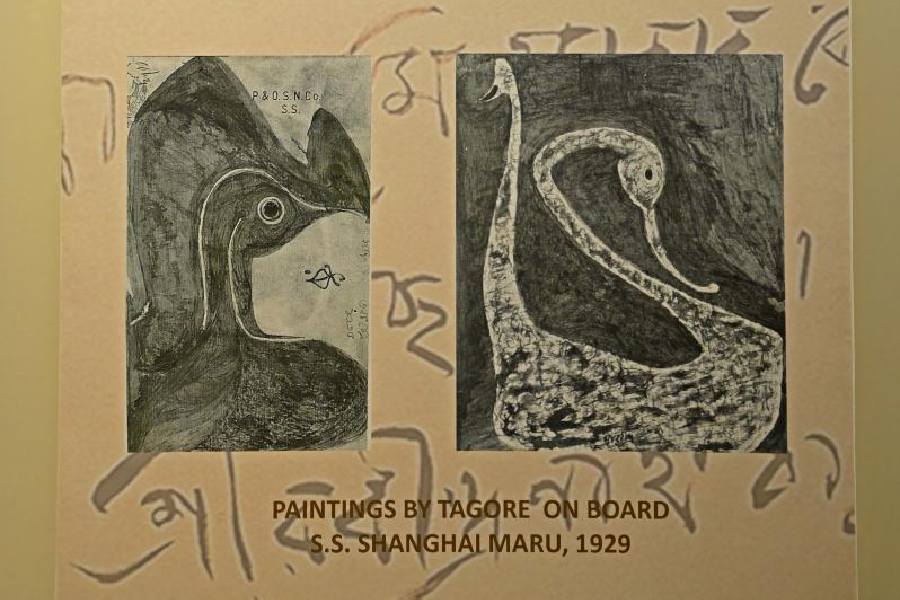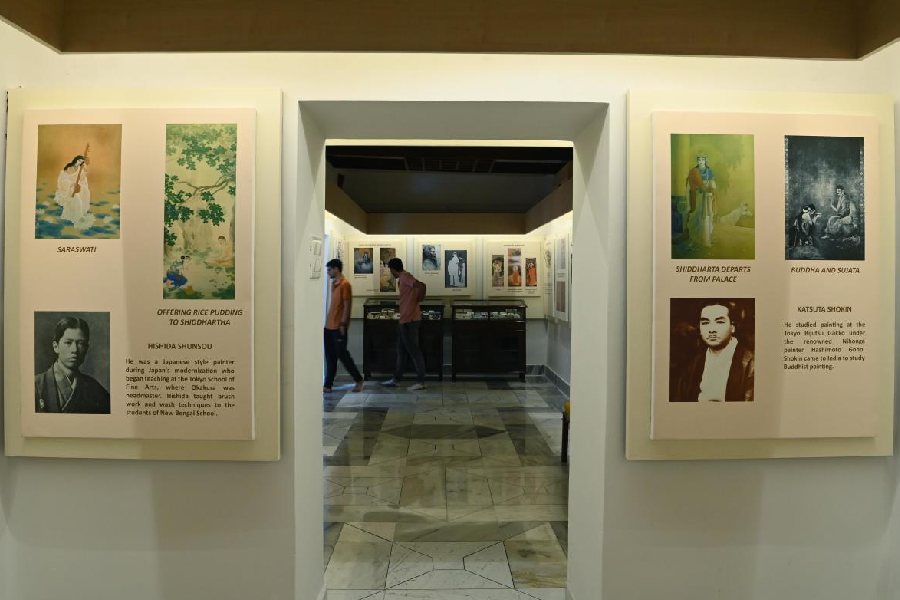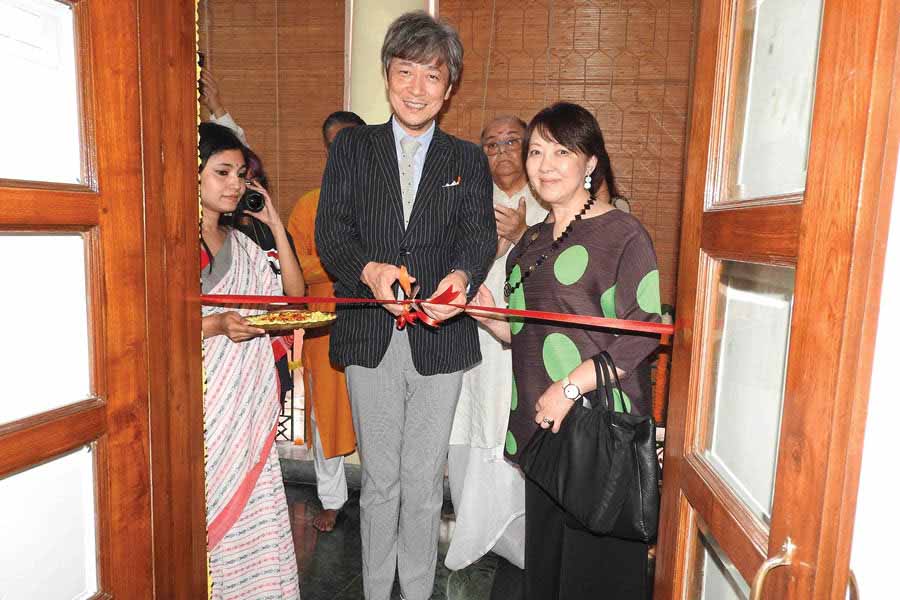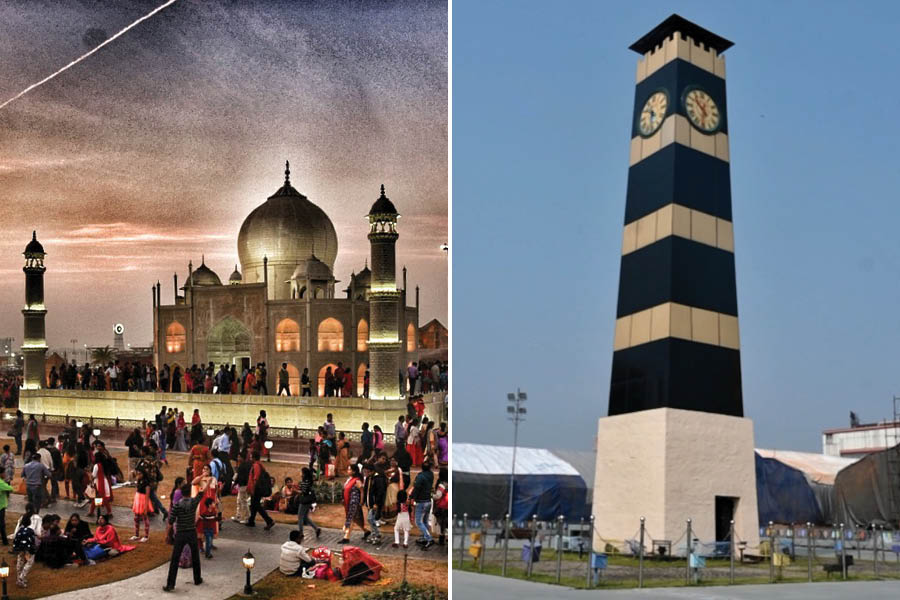The Japan Gallery at Jorasanko Thakurbari has been refurbished on the occasion of the centenary of Tagore’s third visit to Japan in 1924.
Rabindranath Tagore had travelled to Japan in 1916, 1917, 1924 and 1929. His visits are milestones in the Bengal-Japan and India-Japan relations.
Tagore’s interaction with the Japanese started much before his tours to the country as Japanese artists and intellectuals were regular guests at Jorasanko as well as Santiniketan.

Paintings done by Rabindranath Tagore on board- a ship to Japan in 1929
During his tours, Tagore met a large number of people, including the Prime Minister of Japan, leading thinkers, writers, artists, musicians, educationists, politicians and journalists of that country. He delivered a good number of lectures at universities and associations.
And he wrote in detail about his Japan tours in Japan Yatri, which forms the crux of the gallery’s exhibits.
The Japan gallery at Rabindra Bharati Museum, which is housed at Jorasanko Thakurbari, is spread across six rooms. It tries to capture the poet’s tours through his quotes, pictures and paintings.
The Tagores had initiated intellectual and cultural exchanges with Japanese artists and scholars way before his visit to the country.
In 1902, Tagore met Japanese scholar and art critic Okakura Kakuzo at the American consulate in Kolkata. The year Okakura left India, Tagore invited his disciples Taikan Yokoyama and Shimomura Kanzan, along with his colleague Hishida Shunso, to Jorasanko, where they also met Abanindranath Tagore.
Japanese miniature garden artist Kimtaro Kashahara visited Abanindranath in 1911 with his family. He built a hanging room between three banyan trees and called it the Abode of the Poet, where Tagore spent his mornings and wrote poems included in the collection named Purabi.
Tagore invited Jinnosuke Sano as a judo teacher in Santiniketan because he considered judo an art form.
Tagore’s friend and confidant C.F. Andrews wrote: “Through the summer of 1915 the poet’s plans were maturing for a visit to the Far East.... He looked more and more to the time when the Ashram would pass beyond the school stage and become a centre of world fellowship, wherein schools and teachers from the East and the West should be equally honoured and welcomed.”
The gallery has pictures of Tagore with Andrews, Mukul Dey, a then budding artist from Santiniketan, and William Pearson, who had joined Tagore’s school in Santiniketan as a teacher, at Women’s College, Tokyo, in 1916, along with a quote by Tagore from Japan Yatri: “On going out into the streets of Japan, the eye is chiefly attracted by Japanese women. Then one realises it is they who are the home of Japan, the country of Japan....”

Taikan Yokoyama's painting of Kali shows Indian influence on Japanese painters
The gallery also has a display of the Japanese tea ceremony. Tagore was invited to a tea ceremony at Murayama Roheyi’s house, pictures of which are part of the display. Roheyi was the founder and president of Asahi Shinbun, Japan’s largest newspaper. There are references to Roheyi’s garden in Tagore’s Japan Yatri, as also a description of how Roheyi’s daughter prepared tea.
“His daughter entered, and upon bowing to us, set about preparing the tea. From the moment of her entrance into the room her every movement was rhythmic as if under the spell of the ritual. Washing and wiping the utensils, lighting the fire, opening the lid of the teapot, filling it with water, then pouring the tea into cups and presenting it to the guests — all this was done with such discipline and slow grace that it must be seen to be imagined.”
The exhibition also mentions the Great Japan Earthquake of 1923 that struck Yokohama and Tokyo. The initial quake was followed by a 40ft high tsunami. Visva-Bharati had collected funds to send to the quake-hit people of Japan.
The last room is dedicated to the influence of Indian and Japanese art on each other. Japanese artist Kampo Arai taught Nandalal Bose Japanese brush techniques. Bose explained the 13th-century sculpture techniques of Konark to Arai.
Nandalal travelled with Tagore to Japan in 1924. Mukul Dey, a young artist trained by Abanindranath, Nandalal and Asit Halder, accompanied Tagore to Japan in 1916. Dey learnt painting at the Nippon Bijutsu-in or Fine Arts Academy of Japan for nearly three months. A couple of Dey’s paintings are also part of the gallery.
“We have included two of Tagore’s paintings done during his journey by ship to Japan. We have also tried to enrich the display by doing a comparative study of Indian and Japanese influence on paintings of each country. Paintings of Abanindranath and Gaganendranath, along with those of Nandalal and Benodbehari have been included, which show the influence of Japanese brush techniques,” said Baisakhi Mitra, curator, Rabindra Bharati Museum.
The consul general of Japan in Kolkata, Nakagawa Koichi, inaugurated the gallery on February 19 in the presence of Rabindra Bharati University vice-chancellor Subhro Kamal Mukherjee.








